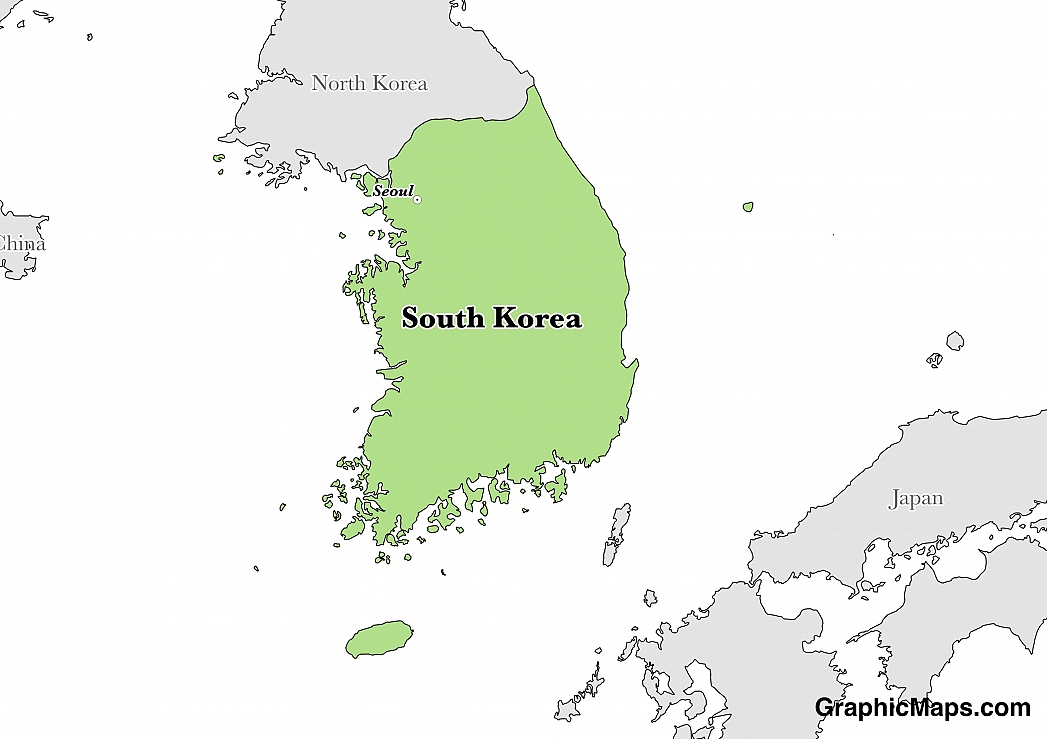Where is South Korea?
Located in Eastern Asia, South Korea has a 237.00 km border with North Korea. It has a 2,413.00 km coastline. The Demilitarized Zone has separated North from South Korea since 1953.
The capital city of South Korea is Seoul. It is located in the northwestern region of the country. The city gained its capital status in 1948 after the division of Korea into two. It is the biggest and most populous city in South Korea. The city was known as Wiryeseong many years ago. The city has around ten million residents living in the city while the large metropolitan area has 25 million residents. Seoul is among the cities with the highest population density. The combination of the modern and ancient architecture makes Seoul an attractive site for tourists from around the world. Some of the attractions in the city include the Seolleung Park Royal Tombs, Seoul Grand Park, amusement parks and Changdeokgung Palace. The climatic conditions experienced in Seoul are hot and wet. The dry months start from December to February while the wettest month is July, when the city receives a significant amount of rainfall. Temperatures are usually 22.4 degree Celsius on the low end and around 29.6 degree Celsius on the high end.
Read more on South Korea's CapitalSouth Korea is an Asian country covering 99,720.00 km2 of which 2.81% is water and 96,920.00 km2 is land. This makes it the 107th largest country in the world and slightly smaller than Pennsylvania; slightly larger than Indiana. Its geographic coordinates are 37 00 N, 127 30 E and Seoul is the capital city.
The name comes from the Chinese name for the Korean dynasty of "Goryeo".
Its ISO code is KR.
Geography
South Korea has a mean elevation of 282 m above sea level.
It has a temperate climate with heavy rainfall in the summer and long, cold winters. Its terrain is mostly made up of hills and mountains, with wide coastal plains in the west and south.
Population
South Korea has a population of 50,924,172 making it the 27th largest in the world. The country's population is primarily concentrated in the lowlands.
Korean is the official language. The ethnicity is reported as raacially homogenous. The majority of the population is non-religious, with significant Protestant and Buddhist minorities.
In South Korea, the standard Korean language is the official and national language used across the whole country although several different dialects exist in different regions. Though thought to belong to Altaic family, Korean has borrowed a lot from Chinese and Japanese languages. English is also widely used in Korea, especially in cities by people below 40 years of age. Other languages used are Mandarin and Cantonese among some Koreans and the Chinese population residing in the country, Japanese is another minor language common in older adults and the regions closer to Japan in the south.
Read more on South Korea's LanguagesThe dialing code for the country is 82.
Government
South Korea is an independent country. It gained independence from Japan in 1945. Its constitution was last ratified in 1948.
The Republic of South Korean is a representative presidential democracy with an elected president as the head of state and government. The Prime Minister deputizes the president and together run the government. The country has a multi-party system that elects a representative to the legislature for a four-year term. All government operations are centralized in the capital city of Seoul. There are two major parties in the country, and they are the Democratic Party of Korea (DPK) and the conservative Liberty Korea Party (LPK). The Presidential residence and office is in Jongno-gu, Seoul. The National Election Commission oversees elections in the country where National Assembly members are elected after every four years.
Read more on South Korea's GovernmentEconomy
The currency of South Korea is the Won (KRW).
Its major export partners are China, the United States, and Hong Kong. Its main exports are semiconductors, petrochemicals, automobile/auto parts, ships, and wireless communication equipment. Its major import partners are China, Japan, and the United States. Its major imports include crude oil, natural gas, coal, and steel.
Flag
The South Korean flag is made up of the 4 colors of white, red, blue, and black. The background of the flag is covered in white. The trigrams on each corner are black, and each of trigram represents an element in nature. The circle is made up of the yin on the top and the yang below. The white color on the flag stands for peace. The blue color on the yin and red on yang stand for the positive and negatives forces of the universe. The Korean flag was created by Ambassador Bak Yeong-Hyo while on a ship. He created the flag when he was appointed the ambassador to the United Kingdom. The creation of the flag was done without the Emperor’s knowledge. Later on, the ambassador notified the emperor about the creation of the flag. The Korean flag was made official by the emperor in 1883. Previous flags of Korea were based on the flag created by the ambassador. Changes only came on the tones used on colors and the shape of the yin and yang. The other difference was on the kwaes used on the flags. The government standardized the Korean flag design for color tones, dimension, and placement of the trigrams. All the flags are made according to the set standardization.
Read more on South Korea's FlagThis page was last modified on January 17th, 2018
More on Graphicmaps

Published on 2019-11-06
What is a Trade Embargo?

Published on 2019-11-04
Which Two Countries Used to Have the Same Flag?

Published on 2019-09-16
What Is the Only Two-Sided State Flag?

Published on 2019-09-16
Which Country Flag Looks Like the Texas Flag?

Published on 2019-08-29
Flags That Resemble the US Flag

Published on 2019-08-20
